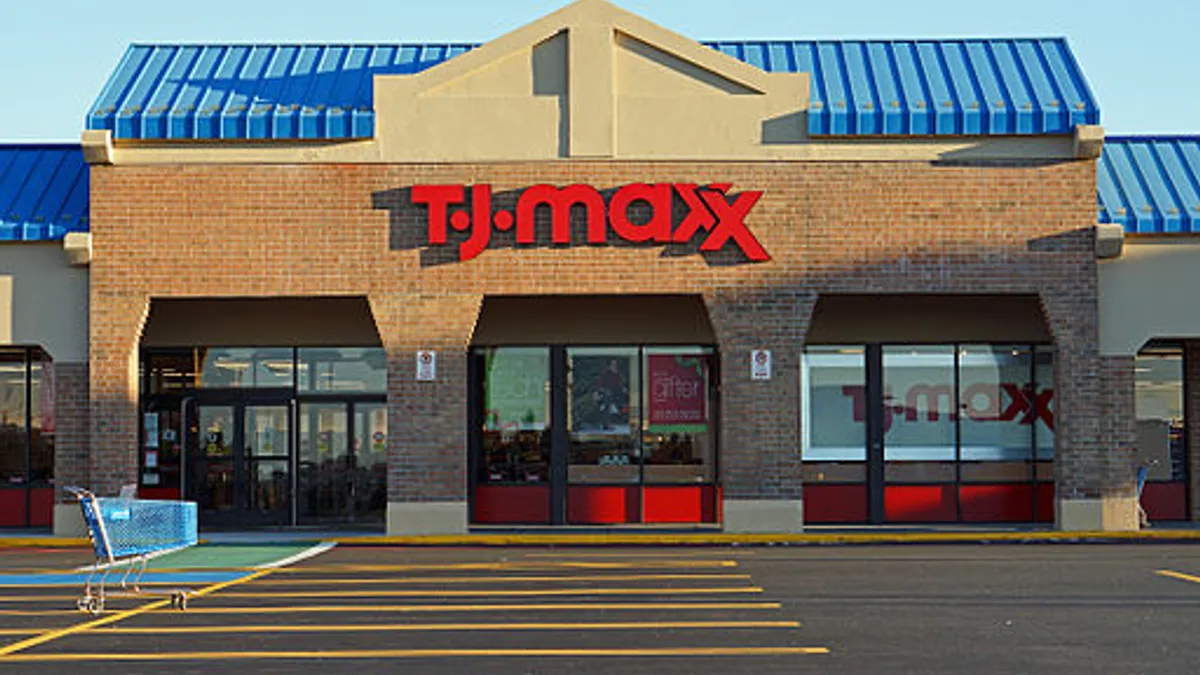Dive Brief:
- TJX Cos. on Tuesday reported that second quarter net sales increased 12% to $9.3 billion and comparable sales increased 6% companywide, according to a press release.
- The retailer posted net income of $740 million, up nearly 34% over the prior-year period, and it raised its guidance on comps and earnings for the fiscal year. Diluted earnings per share and net sales both beat analyst expectations (by 12 cents and $340 million, respectively), according to Seeking Alpha. TJX share prices were up more than 5% in premarket trading.
- TJX said that the spike in comps was primarily driven by increases in customer traffic across divisions. By brand, comps rose 7% at Marmaxx (which operates T.J. Maxx and Marshalls), 3% at Home Goods, 6% at TJX Canada and 4% at TJX International. Over the quarter, the retailer opened a net of 53 stores.
Dive Insight:
The tribulations of mall-based apparel sellers and department stores are alien to TJX and its off-price peers these days. As just one example, here is how the company's CEO, Ernie Herrman, described customer traffic to their stores in Q2:
"Customer traffic was once again the primary driver of our comp store sales increases at all of our divisions as we continue to reach a very wide customer demographic. Further, this marks the 16th straight quarter of customer traffic increases for TJX and Marmaxx. We have been attracting new customers to all our divisions, a significant share of whom are younger customers. This is great for our business today and for the future."
The retailer is fortunate enough not to be tied to the fate of the American mall. Perhaps just as importantly, TJX's business, for now, is well insulated from e-commerce encroachment. While department stores and other retailers are investing like mad in their digital business, often with diminishing returns, TJX and Ross for the most part have stuck with their same formula: offering low, simple prices and a "treasure hunt" approach to shopping, while papering the country with new stores.
TJX has already started the year strong, with a 12% spike in top-line sales and 3% increase in comps in the first quarter. Executives said then that they expected to keep gaining market share, after having already ripped it away from many retailers and sectors, namely department stores as well as traditional mid-tier apparel and home goods sellers.
After a "fashion misstep" at T.J. Maxx and Marshalls in Q3 last year — one that helped drag down comps to negative 1% in the unit in the period — Cowen analyst Oliver Chen said in a February note that his team thought the problem was "largely fixed," with Cowen's consumer tracker pointing to rising visit trends to the retailer's stores. It followed it up with a strong Q4 performance.
While some analysts last year expressed concern that consumers, feeling confident, might trade up and away from off-price, the sales figures this year are not baring that out so far. Other observers expect the good times in the sector to keep rolling. Moody's analysts noted last year that the discovery inherent in off-price shopping will continue to fuel off-price retail, which they expect will generate operating income growth of 5.4%. And analysts with JP Morgan wrote last year that they estimate off-price retailers could generate another $19 billion in incremental sales by 2021, primarily at the expense of department stores.
Neil Saunders, managing director of GlobalData Retail, said Tuesday in emailed comments that his firm's data shows that value pricing has become an "underlying constant in terms of what consumers look for when shopping." He added, "This is both because of a perceived fragility to economic circumstances, which means households worry that their good fortune may not last for long, and because many people simply enjoy the thrill of snagging a bargain."















